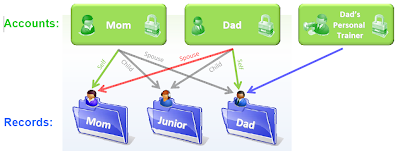I'm at the Microsoft HUG (not "MS-HUG" any more, according to Michael Clifford's opening remarks) Tech Forum in Redmond today and tomorrow. My primary objective is to gain more exposure to HealthVault so that I can bring that knowledge back to my colleagues, but I'll be posting highlights from all of the sessions that I attend.
Opening KeynoteSteve Aylward, General Manager, Health & Life Sciences, Microsoft
I skate to where the puck is going to be, not where it's been.
- Wayne Gretzky
Steve started his presentation with Microsoft's Health Future Vision video (direct link).
The video has a lot of cool, visionary ideas, but I was especially impressed by the sweet TV in the patient's living room. Being a Tucson native, I liked her low-care landscaping (in contrast to the huge lawns in the Salt Lake City area). I was also happy to see that shopping carts wouldn't change.
Microsoft's growth in healthcare market:
2000
63 employees
< $100 million in sales in healthcare market 2008
> 700 dedicated employee
> $1.2 billion in US
> $2 billion in sales world-wide
In 2008, Microsoft invested $8B in R&D. Steve couldn't say how much of that was invested in healthcare, but indicated that it was a large percentage.
Aside from core initiatives like Office, Windows, BizTalk, etc., healthcare is among Microsoft's largest areas of investments.
Other notes:
- Amalga HIS is for emerging markets, where there isn't already a lot of infrastructure in place.
- Amalga Unified Intelligence System: I don't know what this is.
- HealthRamp: "Internet health platform that enables third-parties to create valuable health-related services." That description (pulled from one of Steve's slides) confirms my earlier assessment that Microsoft is taking a more vendor-based approach than Google.
Dr. Albert R. R. Kooiman
Bill Crounse, MD
Unification (via Office 2007) of:
- E-mail and unified messaging
- Instant messaging
- Enterprise telephony
- Conferencing
Dr. Kooiman opened with a demo of Outlook: He selected an e-mail message, then clicked a button to open an IM window with the sender. With another click, he called the sender on the phone. Presumably, another click or two would allow him to conference in another participant to the conversation.
The "Call to Action" for this session was to encourage developers to use Office 2007 as a platform to integrate unified communications into their applications.
Dr. Crouse introduced this video on unified communications on his HealthBlog, and showed it during this presentation. To be honest, I find UC to be more applicable to hospitals than ambulatory clinics, but perhaps there is a more relevant application for larger clinics.
Solving the Difficult Problems of Healthcare and Life Sciences with the Latest Generation of Microsoft Technologies (Developer Track)
Tim Huckaby, CEO, InterKnowlogy
Tim was invited to present because his company has done a lot of cool projects for healthcare organizations using Microsoft technologies. Also, Microsoft is IngerKnowlogy's largest client.
Tim demo'd a WPF application built on top of SharePoint Web services for Scripps research. Visually, the data is represented as complex, hyperlinked, rotatable 3D images, but they're stored as large text files in SharePoint. The graphical performance of WPF is impressive, and the rendering code was written by one developer in one week (although InterKnowlogy had invested heavily in WPF prior to embarking on this project).
Why hasn't WPF been widely adopted?
- It is huge: Larger than ASP and WinForms combined.
- It's a thick client, and thin clients are the current rage.
WPF is built on top of DirectX, and it makes sophisticated graphics much easier to deal with.
Silverlight only contains about 18-20% of the classes available in the full WPF framework.
InterKnowlogy has some some cool Silverlight demo apps.
Microsoft HealthVault Architecture Overview (Developer Track)
Sean Nolan, Chief Architect, Microsoft Corp.
Our bet: Patients as the hub of of communication.
- Sean Nolan's HealthVault presentation
Reasons to Integrate with HealthVault
- Private and Secure Storage
- Authenticate Users, Manage People Relationships
- Share Securely, Authorize Data Access
- Application Interoperability
- Device Connectivity
- Application and Device Discovery
- Developer Assistance
How does Microsoft monetize HealthRamp? (There are no fees or charges to use the platform.) They see healthcare being like travel - opportunities for advertising in the future.
HealthVault can be used in "Native" or "Copy" model:
- Native: Healthvault replaces traditional database and authentication mechanisms
- Copy: HealthVault is an external repository, you can pull data out of it or push data into it (import/export, merge, sync)
HealthVault supports both Windows Live ID and Open ID.
Interesting: All access to HV goes through the XML API (Basic XML over -HTTP interface, POST a request and receive a response)...NOT SOAP! (Although SOAP and WSDL will probably come in the future.)
This is interesting to me because we took the same approach with our core (XMLRPC) API 9 years ago. (In our case, SOAP wasn't fully baked, but we continue to believe that our lightweight version of SOAP is better suited for our application.)
Security, authentication, and access control are very important in HealthVault.
 HL7 Based Data Warehousing: Fast Build to Data Use (IT Pro Track)
HL7 Based Data Warehousing: Fast Build to Data Use (IT Pro Track)
Eric V. Washburn, CTO, Athena Advanced Technologies/HVHS
This was a great opportunity to catch up on e-mail. (Eric did a good job, but his audience was pretty small--few organizations need to do what he did.)

No comments:
Post a Comment